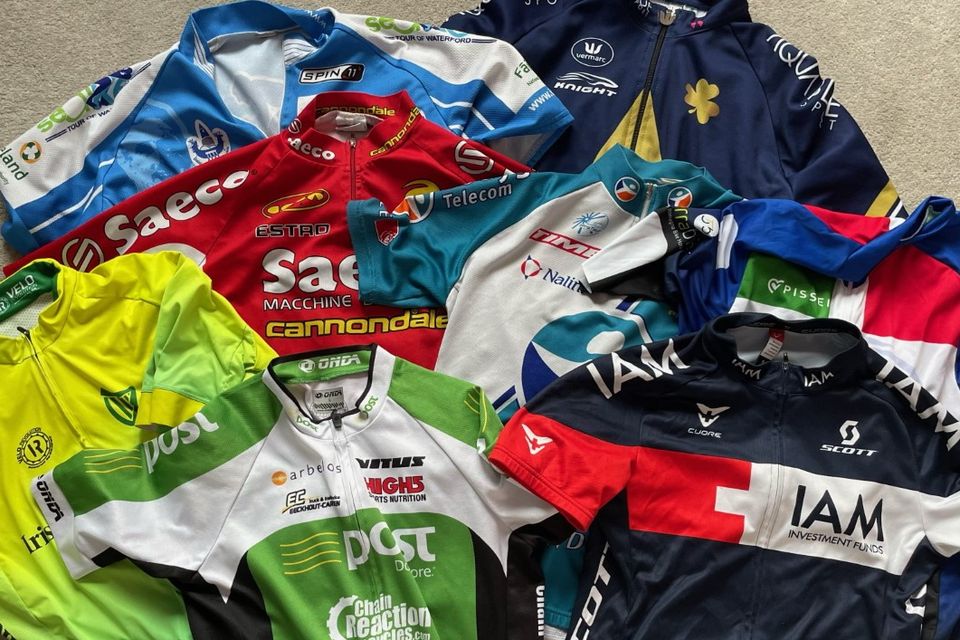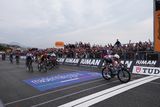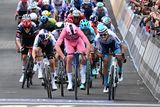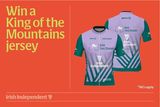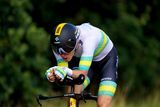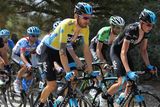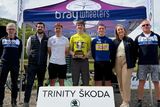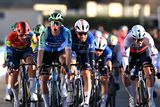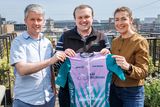ICycle diary: When jerseys last so long, you can always justify adding to the collection
Cycling jerseys never run out of road
It may be spring-cleaning time, but there’s one drawer in our house that never gets emptied out.
Despite my own eagerness to dump out clothes, toys, or anything past its sell-by date, my own collection of cycling jerseys and jackets is never subject to a re-cycling process; it only gets bigger. It helps that each one ages like a classic car.
The styles may change but the jerseys themselves usual remain indestructible.
During the winter and spring months my hand goes into this drawer to pull to an old jersey to add an extra layer to protect me from the elements. And each one that comes out has a story to tell – either a personal one or about the team the jersey represented.
There’s the Bouygues cycling team top that I bought for a week-long bike-packing trip – before it was called bike packing – across France in 2006; the An Post jerseys from a time when Seán Kelly’s team were offering a pathway for rising Irish stars (and would put on great media trips to their training camps in Belgium or Spain); the iconic red Saeco top that conjures up images of the peak of Mario Cipollini’s career; the I AM Cycling jersey that was bought for its unbeatable looks, plain and simple; the Aqua Blue jersey that was purchased when the team collapsed to remember a time when there was an Irish professional team in the peloton – only five years have passed and yet I still can’t help thinking did that whole episode really happen?
More recent purchases have followed the broader trend away from the trade team jerseys. It’s more about understated style and less about the identifiable bright colours and multiple sponsors.
Apart from the Bora-Hansgrohe colours of Sam Bennett, or a few BMC jerseys from Nicolas Roche’s time, you see less of these pro team jerseys on the roads now.
But each edition marked the success, and often scandal (see I AM for multiple examples), of the teams, but it seems the time of the pro-team jersey has faded among the weekend warriors. But no matter what your preference is, when the jerseys last so long, you can always justify adding to the collection.
Send us pictures of your own collection or prized jersey to icycle@independent.ie.
Heart-rate zones
I’ve been using another old cycling accessory with renewed interest in recent weeks to help establish my heart-rate zones for training. My Garmin Edge 800 may be 12 years old but it’s still covering all the bases.
To help with my training, cycling coach Aidan Hammond suggested I get reacquainted with my heart-rate zones.
To establish these, I had to find out my resting heart-rate and my maximum heart-rate. The former measured before I get out of bed in the morning, the latter established on a big hill as I completely emptied the tank.
Some methods for establishing these zones rely only on your maximum heart-rate, but Aidan suggested this is overly simplistic. So I sent my numbers back to him (58 resting; 185 max) and he figured out my ‘zones’ using the Karvonen method.
The formula is: Max heart-rate (HR) minus resting HR. Then you multiply that number by the % zone you want to work in. Then add in your resting HR to get the HR for the % zone
The main zones to work with are:
Zone 1 - 60% Real easy recovery day or recovery between efforts. Zone 2 - 70% Aerobic zone: The main zone you will be working to on long steady spins. Zone 3 - 80% Upper Aerobic: The upper limit on your long steady spins and maybe some of your shorter spins. Zone 4 - 85% Tempo or Sweet spot: Hard effort but not flat out. It's below threshold so you can hold this for long efforts and can talk short sentences and be out of breath a little. Zone 5 - 90% Threshold: This is where you start producing more lactate than the body can clear out, at 90% it's very hard, like a time trial effort you can hold it for long efforts ie 10-20 mins if you're well trained. Yes and no answers only! Zone 6 - 100% Max effort. Very short efforts or v02 max-type efforts.
Which all means, my magic numbers work out as:
Zone 1: 134 Zone 2: 146 Zone 3: 160 Zone 4: 166 Zone 5: 172 Zone 6: 185
This is helpful, particularly, for keeping my long and steady rides within the right zones. For example, for my long, steady, Zone 2-3, spins I must keep my heart-rate between 146-160 and for my uphill strength and endurance reps between 166-172.
I was a bit relieved to see these numbers, as it gives me a little bit more leeway than I thought I'd have for my long and steady rides. I find it takes a lot of discipline to keep within a Zone 2 or 3 heart-rate when you’re faced with even a short hill when you're out on the road.
This week’s cycling – Km covered: 100km over two rides
Events: Fill in the Easter Gap
Glencullen Adventure Park (The GAP) in Co Dublin is running special youth training camps and events over the Easter holidays for ages 8-16 years old. The three-day camps cater for complete beginners, improvers, Intermediate and advanced mountain bikers.
Week 1: April 4, 5, 6 is suitable for beginners/improvers aged 8 -16 years old.
Week 2: April 10, 11, 13 for intermediate/advanced, aged 12-16 years old.
Cost: €190 per week – book online: www.thegap.ie
Serious cycling
Ben Healy and Rory Townsend continued Irish cycling's rich vein of form in the professional peloton with both recording victories in high-profile races in Europe last weekend.
After winning a stage of the Settimana Internazionale Coppi e Bartali last week, Healy then soloed to victory in the GP Industria & Artigianato one-day race in Italy while Townsend took a first win of the season for his new Bolton Equities team by taking some big scalps at the Roue Tourangelle in France.
At home Daire Feeley and Aoife O'Brien won the first rounds of the Cycling Ireland Road National Series, the Donal Crowley Memorial in Blarney. Round 2 of the series, the Des Hanlon Memorial, takes place on Sunday.
If you’d like to highlight an event, your favourite place for a mid-ride pitstop or tell us about your bike rides email icycle@independent.ie
